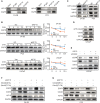KIF15 Promotes Progression of Castration Resistant Prostate Cancer by Activating EGFR Signaling Pathway
- PMID: 34804913
- PMCID: PMC8599584
- DOI: 10.3389/fonc.2021.679173
KIF15 Promotes Progression of Castration Resistant Prostate Cancer by Activating EGFR Signaling Pathway
Abstract
Castration-resistant prostate cancer (CRPC) continues to be a major clinical problem and its underlying mechanisms are still not fully understood. The epidermal growth factor receptor (EGFR) activation is an important event that regulates mitogenic signaling. EGFR signaling plays an important role in the transition from androgen dependence to castration-resistant state in prostate cancer (PCa). Kinesin family member 15 (KIF15) has been suggested to be overexpressed in multiple malignancies. Here, we demonstrate that KIF15 expression is elevated in CRPC. We show that KIF15 contributes to CRPC progression by enhancing the EGFR signaling pathway, which includes complex network intermediates such as mitogen-activated protein kinase (MAPK) and phosphatidylinositol 3-kinase (PI3K)/AKT pathways. In CRPC tumors, increased expression of KIF15 is positively correlated with EGFR protein level. KIF15 binds to EGFR, and prevents EGFR proteins from degradation in a Cdc42-dependent manner. These findings highlight the key role of KIF15 in the development of CRPC and rationalize KIF15 as a potential therapeutic target.
Keywords: CRPC; Cdc42; EGFR; KIF15; protein stability.
Copyright © 2021 Gao, Zhao, Liu, Zhang, Sun, Yin, Wang, Wang, Feng, Qin, Cai, Li, Dong, Chen, Xiong, Liu, Hu, Chen and Han.
Conflict of interest statement
The authors declare that the research was conducted in the absence of any commercial or financial relationships that could be construed as a potential conflict of interest.
Figures






Similar articles
-
Atractylenolide I ameliorated the growth and enzalutamide resistance of castration-resistant prostate cancer by targeting KIF15.Chin Med. 2025 Mar 14;20(1):35. doi: 10.1186/s13020-025-01086-1. Chin Med. 2025. PMID: 40087774 Free PMC article.
-
KIF15-Mediated Stabilization of AR and AR-V7 Contributes to Enzalutamide Resistance in Prostate Cancer.Cancer Res. 2021 Feb 15;81(4):1026-1039. doi: 10.1158/0008-5472.CAN-20-1965. Epub 2020 Dec 4. Cancer Res. 2021. PMID: 33277366
-
Combination of Carmustine and Selenite Inhibits EGFR Mediated Growth Signaling in Androgen-Independent Prostate Cancer Cells.J Cell Biochem. 2017 Dec;118(12):4331-4340. doi: 10.1002/jcb.26086. Epub 2017 May 25. J Cell Biochem. 2017. PMID: 28430389
-
Interplay of Epidermal Growth Factor Receptor and Signal Transducer and Activator of Transcription 3 in Prostate Cancer: Beyond Androgen Receptor Transactivation.Cancers (Basel). 2021 Jul 9;13(14):3452. doi: 10.3390/cancers13143452. Cancers (Basel). 2021. PMID: 34298665 Free PMC article. Review.
-
ZBTB46, SPDEF, and ETV6: Novel Potential Biomarkers and Therapeutic Targets in Castration-Resistant Prostate Cancer.Int J Mol Sci. 2019 Jun 8;20(11):2802. doi: 10.3390/ijms20112802. Int J Mol Sci. 2019. PMID: 31181727 Free PMC article. Review.
Cited by
-
Crosstalk between KIF15 and AR in castrate-resistant prostate cancers.Oncoscience. 2022 Apr 22;9:25-26. doi: 10.18632/oncoscience.556. eCollection 2022. Oncoscience. 2022. PMID: 35479649 Free PMC article. No abstract available.
-
Atractylenolide I ameliorated the growth and enzalutamide resistance of castration-resistant prostate cancer by targeting KIF15.Chin Med. 2025 Mar 14;20(1):35. doi: 10.1186/s13020-025-01086-1. Chin Med. 2025. PMID: 40087774 Free PMC article.
-
The multifaceted role of KIF15 in cancer progression and therapy.Invest New Drugs. 2025 Aug 16. doi: 10.1007/s10637-025-01572-1. Online ahead of print. Invest New Drugs. 2025. PMID: 40817978 Review.
References
LinkOut - more resources
Full Text Sources
Research Materials
Miscellaneous

